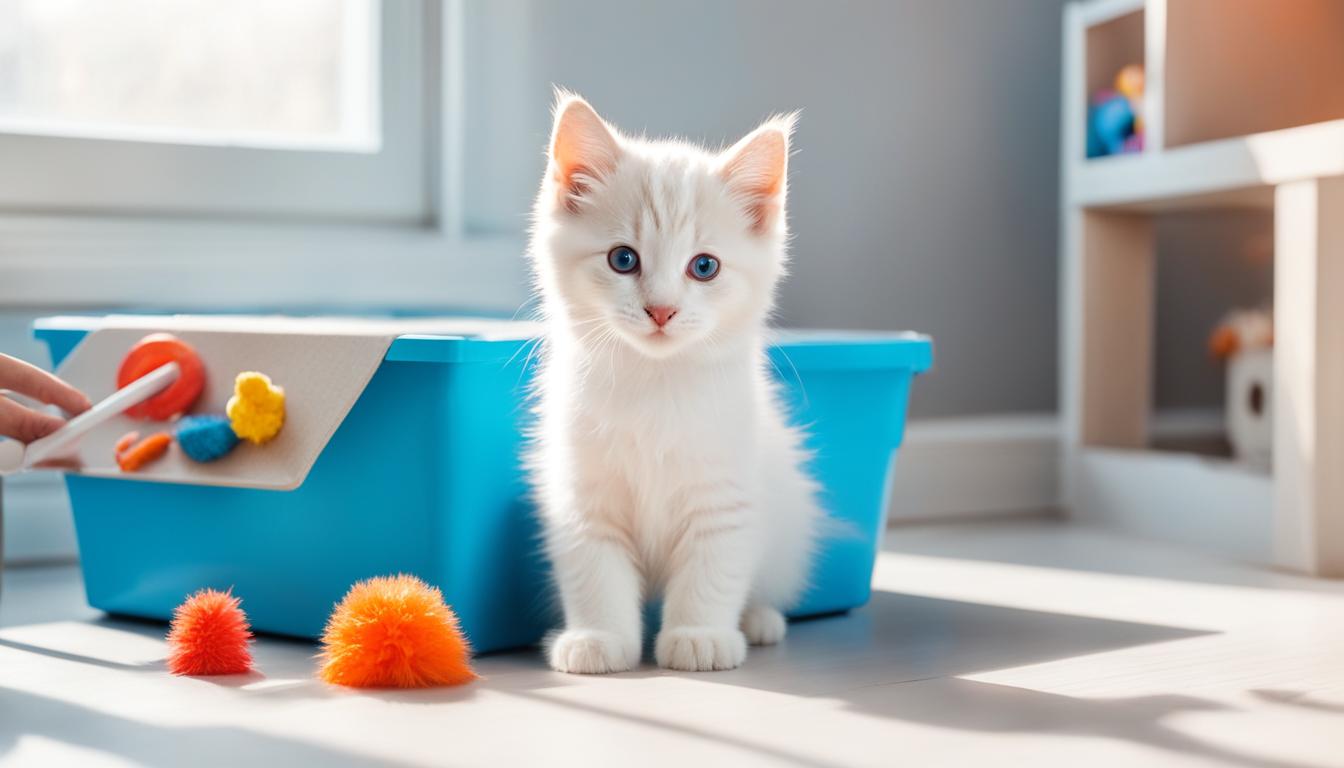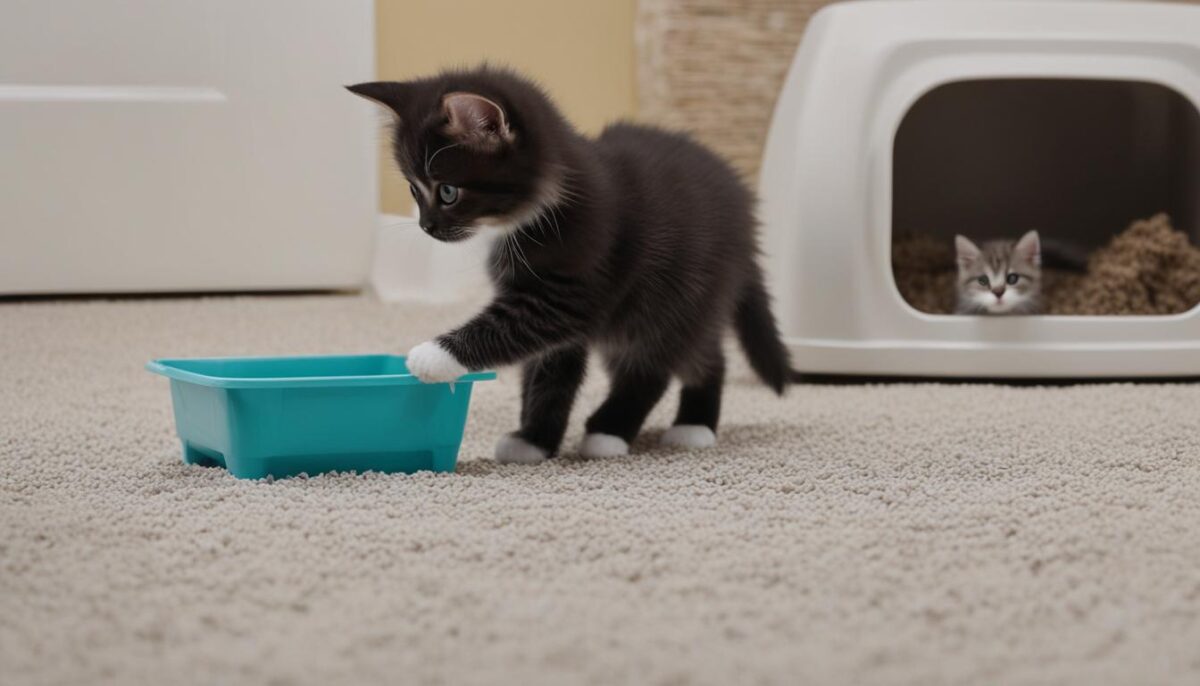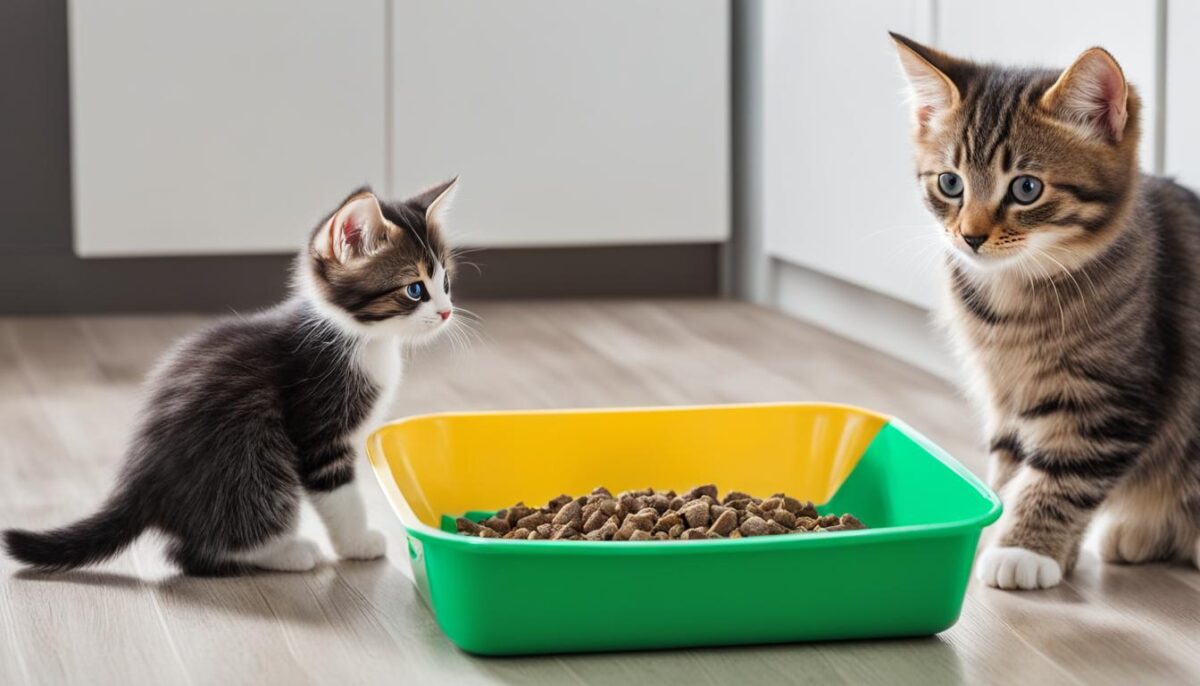Hey there! Are you ready to teach your furry little friend some important house rules? If you’ve just welcomed a tiny bundle of joy into your home, kitten litter training is likely at the top of your to-do list. Don’t worry, though! Cat potty training is not as daunting as it sounds. In fact, kittens have natural litter box habits that make litter box training a breeze. Starting as young as four weeks old, when their weaning process begins, you can gently guide your kitty to become a litter-using pro. Creating a familiar routine and setting up a comfy space for them can do wonders. So, let’s dive in, and we’ll show you how to get started!
Key Takeaways
- Kittens can begin litter training around four weeks old.
- Setting up an accessible and welcoming litter box area is crucial for success.
- Choose a litter and box appropriate for your kitten’s size and preferences.
- Use your kitten’s natural instincts to your advantage during training.
- Be patient and consistent to help your kitten develop good litter box habits.
Understanding Your Kitten’s Natural Instincts
Have you ever noticed how your cute kitten loves to dig and scratch in soft, sandy spots? That’s part of their kitten’s natural behavior. It’s like they have little shovels for paws! When kittens go potty, they really like to cover it up. That’s because of their instinctive litter habits. Mother cats show them how, but they are born knowing a little bit about this too.
When your kitten is around three to four weeks old and starting to eat solid food, they are ready to learn about the litter box—that’s where they should go to the bathroom. We don’t have to teach kittens to use a litter box the same way we teach them to sit or stay, because they naturally understand cat bathroom habits. Isn’t that cool?
Now, let’s look at a list of things kittens naturally do that make litter training easier:
- Digging and scratching in loose, grainy materials.
- Going to the bathroom in a spot where they can hide their waste.
- Following what their mom does, like using the litter box.
If we give kittens the right kind of litter and a good place for their bathroom, they will usually understand what to do.
| Age of Kitten | Ready to Start Litter Training? | What You Can Do |
|---|---|---|
| Under 3 weeks old | Not yet | Keep them with mom, they’re learning by watching her |
| 3-4 weeks old | Yes! | Introduce them to a litter box with kitten-friendly litter |
| Older than 4 weeks | Yes! | Make sure the litter box is always clean and easy for them to find |
Remember, kittens like to keep things tidy and they want their potty place to be just right. With a little help from you, they’ll be using the litter box like pros in no time!
Preparing the Right Environment for Litter Training
Setting up the perfect spot for your kitten to learn litter box habits is a big part of helping them do their business. It’s like making a cozy little bathroom just for them! Remember, it should be easy for your kitten to get to and super peaceful. This means not hiding it in a corner but putting it somewhere your kitten can find fast, without feeling scared or trapped.
Selecting the Ideal Litter Box Location
You want a quiet litter box area that your kitten can reach without a fuss. If you live in a house with more than one floor, put a litter box on each level. That way, your kitten doesn’t have to climb stairs when it’s time to go. Keep it bright too! If it’s too dark, a little night-light can make things better.
Choosing the Correct Litter Box Size and Style
First off, get your kitten a litter box that’s just the right size. Dr. Sally J. Foote says a kitten litter box size should start small. When your kitten grows, you’ll need a bigger box, but let’s start with one that’s 13 inches by 9 inches. Offer both uncovered litter boxes and covered ones to see which kind your kitten likes best.
Picking the Best Cat Litter
Kittens usually love fine-grain litter. It’s soft and feels good under their paws! Try out different cat litter types, like clumping litter or natural ones like corn or wheat-based. Your kitten will tell you which one they like the most, and remember, nothing that smells like food, please!
Take a look at this table to help you understand the difference between types of litter:
| Type of Litter | Texture | Is it Kitten-Friendly? | Notes |
|---|---|---|---|
| Clumping | Fine-Grain | Yes | Easy to clean, forms little clumps |
| Non-Clumping | Varies | Sometimes | May need more frequent changing |
| Clay-Based | Fine to Medium Grain | Yes | Popular choice, affordable |
| Corn-Based | Medium Grain | Yes | Natural option, biodegradable |
| Wheat-Based | Medium Grain | Yes | Another natural, biodegradable choice |
Now that you know where to put the litter box and which kinds to use, your kitten will be learning in no time. A happy kitten means a happy home!
How to Litter Train a Kitten
Starting your kitten on the path to litter box training can be a delightful journey filled with learning and bonding. Here are simplified steps to litter train a kitten and make the process of teaching kittens a stress-free experience for both you and your furry friend.
- Introduce the Litter Box: Begin by showing your kitten the litter box. Let them sniff and explore it. This is their new toilet!
- Seeing If They Catch On: Place your kitten in the box after they eat or wake up from a nap. They may start to dig and use it on their own. If they look confused, gently take their paw and scratch the litter to show how it’s done.
- Watch for Signs: Kittens often need to go after playing, eating or sleeping. Look out for when they start sniffing around or squatting – that’s your cue to quickly place them in the litter box.
- Keeping Things Tidy: Clean the box regularly, at least once a day. Kittens like a clean place when they need to go.
- Praise and Patience: When your kitten uses the litter box right, give lots of praise. And remember, patience is key—they’ll get the hang of it soon!
Remember, every kitten is unique and might learn at their own pace. If you stay calm, patient, and positive, your kitten will be litter box trained before you know it.
| Activity | Step | Pro Tip |
|---|---|---|
| Eating | Lead kitten to litter box. | Keep the litter box close to where they eat but not too close! |
| Playing | Place them in the box after playtime. | Have a litter box in the play area for quick access. |
| Waking Up | Direct them to the litter box upon waking. | Kittens usually need to go right when they wake up, so be ready. |
| Successful Use | Praise and cuddle! | Positive reinforcement works wonders for good habits. |
With these steps, kitten litter box training becomes an enjoyable and fulfilling endeavor. Keep up with the routine, and soon enough, you won’t have to worry about accidents. You’re not just teaching kittens how to use a litter box—you’re helping them grow into happy, well-behaved pets. Good luck on your training adventure!
Cultivating Good Litter Box Habits
Teaching your kitten to use a litter box is important. You want your kitten to be happy and your house to be clean. Let us learn how to help your kitten make good litter habits. You can use yummy kitten training treats and give them every time your kitten does it right. Let’s find out more!
Positive Reinforcement Techniques
One of the best ways to help kittens learn is called reward-based training. When your kitten uses the litter box, you should give them a treat right away. This will help them understand that using their litter box is a good thing. Make sure to keep doing this every time to help them remember.
Establishing a Cleaning Routine
Keeping the litter box clean is very important. Use a scoop to take out the used litter every time your kitten goes. If you do this, your kitten will want to keep using the box because it’s clean. As your kitten gets better at using the box, you can scoop it every day instead of every time.
Handling Accidents Gracefully
Sometimes accidents happen. It’s okay. Do not get mad at your kitten. Instead, clean the spot where the accident happened with a special enzyme cleaner. This cleaner gets rid of the smell so your kitten won’t want to go there again. This helps keep your home clean and your kitten learning the right way to do things.
Maintaining Litter Hygiene: It’s very important to keep the litter box fresh. Replace the old litter with new litter every one to two weeks. This will help your kitten want to use the box and not make mistakes.
| Why It’s Important | What You Can Do |
|---|---|
| Make the litter box a happy place | Give treats after using the box |
| Keep the litter box clean | Scoop the box and change the litter regularly |
| Help your kitten if they have an accident | Use an enzyme cleaner and stay calm |
Remember, if you stay positive and keep things clean, you will help your kitten learn to use the litter box without any accidents. Your kitten will be happy, and you will be happy too! Keep practicing these steps for the best litter box hygiene at home.
Addressing Common Litter Training Challenges
When you’re faced with litter box troubleshooting, know that patience is key. If your kitten won’t use the litter box, the first step is to make sure the box is easy for them to get to and not scary. Make sure it’s in a place that’s quiet and not too busy. If the regular spot does not work, trying a new spot might help.
If they’re still not using it, try changing the kind of litter. Every kitten is different and sometimes they like one kind over another. Keeping the litter box super clean can also make your kitten more likely to use it. Another thing you can do is use things that make nice smells, like pheromone diffusers, which help your kitten feel calm.
Remember, if you think something might be wrong, like a UTI or little bugs in their tummy, you should call the vet. Now, check out these litter box solutions in the table below:
| Problem | Solution | Reason to Try It |
|---|---|---|
| Kitten avoids the litter box | Move to a quieter location | Kittens need a safe space |
| Litter box is always dirty | Clean more often | Dirty boxes are no fun for kittens |
| Kitten doesn’t like the litter | Try a different type | Some kittens are picky |
| Kitten seems nervous | Use pheromone diffusers | Helps your kitten stay relaxed |
If you try these tips and your kitten starts using the litter box, great job! If not, it’s okay to ask a vet for help. They know lots about kittens and how to keep them happy and healthy.
Conclusion
With a little time and care, successful litter training is not just possible, it’s often quite simple. Remember, your kitten wants to be clean just as much as you do! It’s all about teamwork. When you pay close attention, you’ll understand what your furry friend prefers. This means finding just the right spot for that litter box and picking out litter they like walking on. Your patience and careful watching make all the difference.
Make use of these litter box training tips we’ve talked about, and you’ll likely find that your kitten catches on quickly. When they do, you’ve got a happy kitten – and you’ll be happy too, knowing you have a clean home for both of you to enjoy. Your kitten is smart and with your help, they’ll figure out exactly where to go when it’s time to use the litter box.
So keep things easy, stay calm, and before you know it, your new little friend will have those important litter box habits down. Following these guidelines will help assure that your home environment remains pleasant for both you and your kitten, fostering a harmonious relationship. It’s a beautiful thing to see your kitten grow and thrive with the training you’ve provided!
FAQ
At what age can you start litter training a kitten?
You can begin litter training a kitten at about four weeks old, coinciding with the timeframe when they start weaning and transitioning to solid food.
Why do kittens naturally use a litter box?
Kittens have an instinctive behavior to seek out a granular space to eliminate. This natural inclination makes it easier to guide them towards using a litter box.
What type of litter box is best for a young kitten?
A smaller litter box, about 13 by 9 inches, is ideal for young kittens as it’s not daunting for them and allows easy access. Over time, you should increase the size to accommodate the kitten’s growth.
How many litter boxes should I have in my home?
Provide more litter boxes than the number of cats you have, ensuring there’s at least one on every level of your home. This makes it convenient and accessible for kittens to use.
What types of litter can I use for kitten litter training?
Most kittens prefer fine-grain litter, such as clumping, non-clumping, clay, corn, or wheat-based litters. It’s essential to avoid scented litters or those containing materials that smell like food.
What are the initial steps for litter training a kitten?
Begin by introducing the kitten to the litter box and allowing them to explore. Gently place them in the box after eating, drinking, or napping to familiarize them with the routine of using it.
How can I use positive reinforcement to encourage good litter habits?
Reward your kitten with treats immediately after they successfully use the litter box to create a positive association and reinforce the behavior.
What is the recommended cleaning schedule for a kitten’s litter box?
During the initial training period, scoop the litter box ideally after every use to maintain cleanliness. Once your kitten is using the box regularly, you can switch to daily scooping.
What should I do if my kitten has an accident outside the litter box?
Clean the accident area with an enzymatic cleaner to remove the scent and avoid displaying anger towards the kitten, which could create a negative association with the litter box.
My kitten is reluctant to use the litter box. What should I do?
Assess your litter box placement, ensuring it’s in a quiet, safe, and accessible area. Consider trying different litter or box styles if necessary, and consult a vet if medical issues are suspected.


